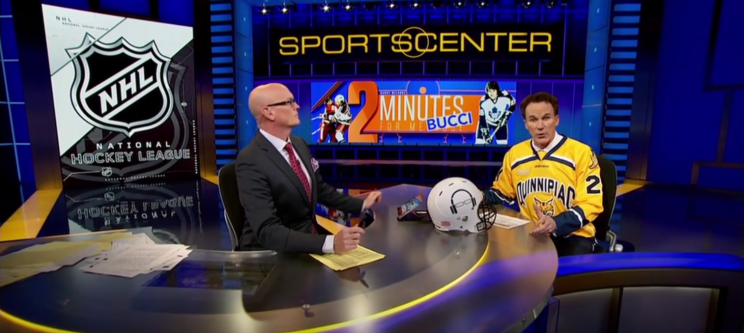ESPN will cut more than 40 on-air personalities in May
As more Americans cut the cable cord, ESPN has seen its subscriber numbers drop steadily, forcing Disney to demand cost-cutting from the “worldwide leader in sports.” It’s been widely reported since March that the next big round of ESPN layoffs will hit on-air talent, but now we know more on the timing: the cuts will begin on May 1, sources at ESPN tell Yahoo Finance.
ESPN will part ways with more than 40 people, all of them “talent,” a label that ESPN applies to radio hosts and writers (almost all of whom regularly do video or audio), not just traditional TV personalities. ESPN says it has 1,000 people in the category. Still, you can expect most of the people cut to be faces you’ve seen on TV. In some cases, ESPN may buy people out of existing long-term contracts—as Sports Illustrated points out, that is unusual.
The cuts will mostly be done by May 9, when Disney announces its quarterly earnings, but could extend until May 16, when ESPN presents its annual Upfronts in Manhattan.
In a statement, an ESPN spokesperson said the approaching cuts are about innovating to suit the needs of consumers: “Today’s fans consume content in many different ways and we are in a continuous process of adapting to change and improving what we do. Inevitably that has consequences for how we utilize our talent. We are confident that ESPN will continue to have a roster of talent that is unequaled in sports.”
ESPN’s last major layoff round was in 2015, when it cut around 300 employees—a much larger number than is coming in May, but this time it’s viewer-facing, recognizable names. Before that, ESPN cut around 300 people in 2013, so we see a recent pattern of big layoffs every two years.
The reasons are clear if you’ve followed the fallout of cord-cutting: ESPN (and Fox Sports 1 just as much) is seeing viewership fall and rights fees continue to rise. ESPN pays fat fees for the right to show Monday Night Football ($1.9 billion per year through 2021), NBA games ($1.4 billion through 2025) and the College Football Playoff ($600 million through 2026), to name just a few. Its total programming costs are up to $8 billion this year. The situation is not tenable.
Disney does not break out the financials of ESPN, but includes it in its media division. In Disney’s fourth quarter of 2016, revenue for its media division fell 3% and revenue for cable networks fell 6.8% year over year. Disney did say that ESPN had “lower advertising and affiliate revenue” in the quarter. In Disney’s first quarter of 2017, revenues in the media division fell 2% and operating income fell 4% year over year. Again, the causes were higher programming costs, fewer subscribers. In October of last year, ESPN had its worst month ever, losing 621,000 subscribers, according to Nielsen.
But parting ways with expensive talent won’t just slim the network down fiscally—it could arguably improve ESPN’s image and modernize its identity. In the past two years, Bill Simmons, Colin Cowherd, Keith Olbermann, Jason Whitlock, Mike Tirico, and Skip Bayless all left the network, some by choice and some via firing. There’s a reasonable argument to be made that the network can thrive without such veterans. That’s not to say that it’s about to show all of its expensive, recognizable talent the door. The question is which expensive talent will remain.
While no one knows (or isn’t telling) which people will be let go next month (The New York Daily News has some speculation, including SportsCenter anchor John Buccigross, whose contract expires on July 1), it’s easier to guess at which personalities are safe: Scott Van Pelt, whose midnight SportsCenter slot has done well; Michael Smith and Jemele Hill, who have just been given the 6 pm SportsCenter slot; Mike Greenberg, who is leaving the long-running “Mike and Mike” radio show and getting his own show; and the main hosts of ESPN College GameDay, the network’s extremely successful Saturday college football franchise. It’s likely that many of the people cut will be lesser-known on-air correspondents that aren’t the face of a show in the network’s main lineup.

Another new step that will help ESPN very soon: parent company Disney’s close relationship with BAM Tech, the spun-off video business of Major League Baseball Advanced Media (“BAM”). Last August, Disney spent $1 billion to get a 33% ownership stake in BAM Tech. In four years it will get the option to buy another third, giving it the majority ownership—expect it to take that option. Disney has said that it plans to have BAM Tech build an OTT (over-the-top) streaming service for ESPN. Giving a standalone option with a monthly subscription fee, a la HBO Now, would help ESPN hold on to some of the young sports fans who don’t want a full cable subscription.
As the first week of May approaches, anxiety is high at headquarters in Bristol, Conn., multiple current employees say. By halfway through May, we will know for sure which recognizable faces at ESPN will no longer represent the network.
—
Daniel Roberts is the sports business writer at Yahoo Finance. Follow him on Twitter at @readDanwrite.
Read more:
How ESPN’s talent exodus could actually save it
Hulu skinny bundle is the latest sign of Disney and Fox yielding to cord-cutting

